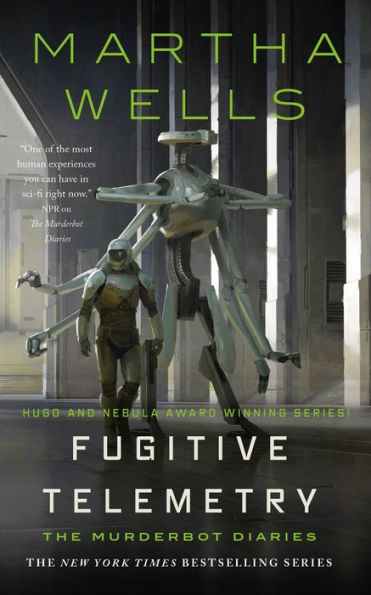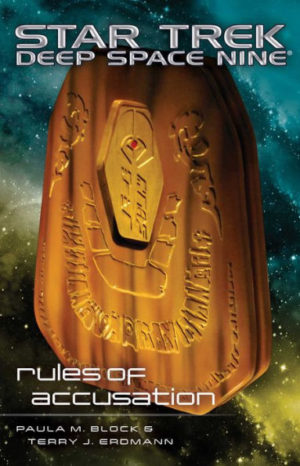Rules of Accusation
Paula M. Block and Terry J. Erdmann
Publication Date: July 2016
Timeline: 2371, December 2385 (after The Missing, before Sacraments of Fire)
Progress: In a Prelude set in 2371, a Kalpazan forger and art collector by the name of Bartleby creates a duplicate of what we will soon figure out is the original Sacred Scroll containing the legendary Ferengi Rules of Acquisition, created by Gint ten thousand years ago. The identity of Bartleby’s client is not revealed.
Fourteen years later, in the story’s present, Quark is bemoaning the fact that he can’t legitimately call his bar on the new station the official Ferengi embassy until the Grand Nagus formally dedicates it. To Quark’s annoyance, Rom has been putting this off for a while, but Quark is undeterred and tries again. This time Leeta persuades Rom to take care of business, suggesting that they think of their trip to the new station as a kind of second honeymoon. With confirmation of Rom’s attendance in hand, Quark immediately compiles a list of VIFs (Very Important Ferengi), but finds the response rate of his invitees lackluster. O’Brien suggests that attendees might be excited to see the original text containing the Rules of Acquisition, which Shmenge once saw and describes as “written on delicate parchment, and decorated with dried liquid latinum.” Quark convinces Rom to exercise his nagal privilege and retrieve the Scroll from safekeeping at the Vaults of Opulence for a temporary exhibit on Deep Space Nine.
Buy the Book


Fugitive Telemetry
When the day arrives, all begins well, with Quark’s high-ranking guests suitably impressed by the exhibit. It isn’t long before the proceedings are horribly spoiled by Brunt, though, who manages to expose the scroll as a holographic fake. Outraged, Quark enlists station personnel for assistance, arguing that he’s the victim of a crime; Odo reluctantly takes on the case (since this is a Ferengi embassy), partnering with Blackmeer. Their investigation reveals that a pair of Dopterians are culpable. When pressed for the reason for their theft, they simply refer to the value of the latinum ink on the parchment.
Upon retrieving the parchment, Quark’s initial joy is completely soured when he determines that this scroll is also a fake. When Zek and Ishka learn of this, Zek is nonplussed, confessing that he himself had the fake put in the Vaults fourteen years prior. He gave the real scroll to Maihar’du, but doesn’t know where Maihar’du has stashed it. Odo flies himself to Ferenginar and tracks down Maihar’du—and the scroll, which turns out to be in Maihar’du’s socks drawer. There’s only one problem: This scroll turns out to be yet another forgery.
Meanwhile, none other than Morn is following the developing news story at a bar on the faraway world of Enterol VI, and we learn from Zek that it was Morn whom he entrusted to obtain a convincing forgery of the original scroll. Unbeknownst to both Morn and Zek, who was Grand Nagus at the time, he got two forgeries back, rather than the original and its copy. Realizing what’s happened, Morn chases down Bartleby and compels him to hand over the authentic document, which he had kept purely for its collectible beauty. Morn travels to the new station and discretely gives the scroll to Bena, daughter of Rom and Leeta. With everyone’s reputations more or less rehabilitated, and the correct scroll now in Rom’s hands, the Grand Nagus returns to Ferenginar, and Quark wonders if Morn will reappear on the station someday.
Behind the lines: For readers who haven’t been following along with this series, here’s a recap of my thoughts on Ferengi-centric DS9 episodes. I enjoyed Paula M. Block and Terry J. Erdmann’s previous Ferengi e-novella, Lust’s Latinum Lost (and Found), and expected a similar casually merrymaking experience this time. What a delightful surprise, then, to discover that this writing dynamic duo have leveled up their craft since their first piece of published fiction. With Rules of Accusation, they’ve created a pitch-perfect, absolute standout tale of comedic hijinks. This adventure has now risen to the ranks of a favorite Ferengi episode for me—the detail of it being literary, rather than filmed, notwithstanding.
The storytelling has the same briskness as the last novella, but the transitions are smoother, and there’s a greater sense of assuredness in the scene constructions. The dialogue remains top-notch, with every nuance of our beloved characters lovingly and amusingly replicated for our delight. Even small characters, like reporter Eisla Darvis, are succinctly and entertainingly characterized. Block and Erdmann have a little fun with the prose too, occasionally inserting playful elements that shake up the narrative, like the text of Quark’s invitation, in Chapter 6, or the reference to Mudd’s Interstellar Travel Guide to the Alpha Quadrant (182nd Federation edition) when introducing Enterol VI.
The continuity is cleverly handled. While this story folds into the current reread timeline, it can be enjoyed as a standalone, and uses its placement in the chronology to reunite legacy characters. Perhaps most notably, Odo is around, and ends up playing a significant role in the plot. Quark’s event is a perfect excuse to bring back many familiar Ferengi faces, too. For a reader imagining this story unfolding on the preceding station, rather than the current one, perhaps Captain Ro Laren would be the strongest reminder of the personnel changes over the years. Her presence is well handled and her interactions with Quark remain charming.
In terms of continuity between this and the previous novella, we get a satisfying follow-up to the Vulcan Love Slave episode:
T’lana—or whatever her real name was—and her writing partner, Pel, were both extremely busy, commissioned to create a musical production of Vulcan Love Slave for the new entertainment dome being constructed as part of the massive Federation revitalization project on Risa. Quark couldn’t stand the thought of how much profit they stood to gain if the endeavor was a success.
“Giddy” is not a term I tend to use often in reviews, but the return of Morn, albeit in limited fashion, more than merits it here as descriptor of my response. Block and Erdmann even give us a few scenes from Morn’s point of view, without at all ruining his mystique. Wisely, they don’t give him any actual lines of dialogue. “It’s all over when the Lurian leaves your bar,” is one of several lovely Morn-related observations, and I hope the whole “where is Morn?” thread for the last David R. George III novel doesn’t mess with Morn’s magic in this tale in subsequent volumes.
I want to single out a couple of specific scenes for their cuteness and heartwarming effect. This one is definitely memorable:
As quickly as Quark could mix drinks, Rom delivered them. In no time at all, they fell into their old rhythm of working together, just as they’d done for years. As if they’d been doing it every day, without a hiatus.
And speaking of Odo, here is another beautiful moment:
He slid off the barstool and headed for the door. As he walked, his body rippled, its surface shimmering, melting, and re-forming. By the time he entered the Plaza, the investigator was wearing his old Bajoran uniform, now somewhat out of date compared to those of the current Bajoran militia members. But that didn’t matter. He wasn’t masquerading as one of them. He just wanted to wear something that matched his state of mind.
The story itself manages to elegantly integrate elements of various sub-genres, like the locked-room (or in this case, locked-space station) mystery and the noir thriller. Film buffs will pick up several Casablanca-isms. There are other amusing allusions too, like the use of “It’s a fake!”, famously uttered by the Romulan Vreenak under very different circumstances. The toy of Dilb the Destitute, “still in the original box,” is another fantastic send-up.
What a pleasant couple of hours this made for. Perhaps there’s some wisdom to Rule #284 after all, which would have us believe that “Deep inside, everyone’s a Ferengi.”
Memorable beats:
O’Brien: “I forgot that I was dealing with a species that doesn’t read.”
Brunt: “It was nothing personal, Quark. I was just doing my job. The fact that I enjoyed doing it is neither here nor there.”
Odo: “Quark’s schemes always end up the same way. He plans everything to the last detail, and things start out well. Really well. Then—boom.”
Orb factor: A perfect case of less latinum being equal to more satisfaction; a highly collectable suite of 10 orbs.
In our next installment: We’ll be back in this space on Wednesday, December 9th with David R. George III’s The Long Mirage!
Alvaro is a Hugo- and Locus-award finalist who has published some forty stories in professional magazines and anthologies, as well as over a hundred essays, reviews, and interviews. Nag him @AZinosAmaro.










